Storytelling is not just a literary tool or the art of storytelling. It’s also a practical tool that can be used in marketing – including blog content optimization. Modern content marketing is no longer just about providing information or promoting products. Today it’s about building relationships with readers, engaging them and inspiring them to take action. To this end, storytelling can be a key part of the strategy. In today’s blog post, you will learn how you can effectively use storytelling in your blog content optimization process to achieve better SEO results and attract more readers.

Earn more by optimizing your internet marketing
I will prepare an action strategy and, together with my team, implement it for you.
Storytelling what is it?
Storytelling is the art of telling a story through words, images, sounds or other means of expression. It is the way people communicate their experiences, emotions, beliefs and values, creating coherent narratives. Storytelling plays an important role in communication, both in everyday life and in business. Stories can be used to inform, inspire, bond with audiences and influence their thoughts and actions. In effective storytelling, the key is to create interesting, coherent and authentic narratives that capture the attention and engage listeners or readers.
Storytelling on a company blog – how to get started?
Storytelling is an effective strategy that can be used to optimize content for a blog. It allows not only to convey information, but also to engage readers and create an emotional bond. Here are the steps you can take:
1. understand your target audience
- Before starting the storytelling process, understand who your readers are, what their needs are and what stories might interest them.
2. identify the purpose of the narrative
- Think about what goal you want to achieve with storytelling. Do you want to build brand awareness, inspire readers, or provide specific information?
3. choose a theme
- Choose a topic that is related to the content on a particular blog category page. Stories should be consistent with the theme to keep the content consistent.
4. create authentic stories
- Try to tell authentic stories that have value and meaning for readers. Avoid overdramatization.
5. use narrative as an introduction
- Introduce readers to the narrative at the very beginning of the blog category page. Describe what the category will be about and what stories will be presented.
6. continue the narrative on the subpages
- If you have sub-pages in a category, continue the narrative on those pages, creating consistency of content.
7. use multimedia
- In addition to text, use multimedia such as photos, videos or infographics to enhance the narrative.
8. engage readers
- Encourage readers to participate in the narrative, such as through comments, content sharing or contests.
9. monitor results
- Analyze the results of your narrative, check what stories and content are the most popular and engaging for readers.
10. customize the narrative
- Based on your analysis of the results, adjust the narrative to better meet your readers’ needs and expectations.
What phrases to use when using storytelling?
Using the right phrases in storytelling can help create emotionally engaging narratives. Here are some examples of phrases you can use to make your posts attractive and engaging:
“One day…”
- This is a classic way to start a story. “One Day” introduces the reader to a specific moment in time and arouses curiosity about what happened on a particular day.
“In the beginning…”
- This phrase can be used to tell a story from the beginning, usually in the context of development or change.
“Once upon a time…”
- This phrase is often associated with fairy tales and legends. It can be used to create the atmosphere of a fairy tale story.
“In one of my most important experiences…”
- This phrase introduces an element of the author’s personal relationship with the story and can help the reader identify with the narrator.
“I was/started/discovered…”
- These phrases allow the story to be told from a first-person perspective, which can be more emotional and engaging.
“Let me tell you a story…”
- It’s an invitation to listen to the story, which can capture the reader’s attention and encourage him to continue reading.
“It was a moment that changed everything…”
- This phrase suggests that the story describes a key moment or turning point, which can be very intriguing.
“What if…”
- This phrase can be used to explore alternative scenarios and inspire readers to think.
“It all started with…”
- This is an introduction to the story from the beginning, which can help the reader understand the context.
“That’s why it’s so important…”
- This phrase can be used to emphasize the importance of the story and convey its main message.
The key to using these phrases effectively is to adapt them to the context and content of the story. It is important that the phrases are authentic and resonate with the emotional message you want to convey.
Summary
Storytelling is an integral part of modern content marketing that can significantly impact the effectiveness of your blog. By creating interesting and engaging narratives, you can capture your readers’ attention, build relationships with them, and communicate your beliefs or values. However, remember that storytelling is not only about technique, but also about authenticity and consistency of content. Therefore, carefully plan your stories, ensure their quality and tailor them to the needs of your target audience. By using storytelling in your blog content optimization process, you can not only achieve better SEO results, but also build reader loyalty and turn your readers into an engaged community.











